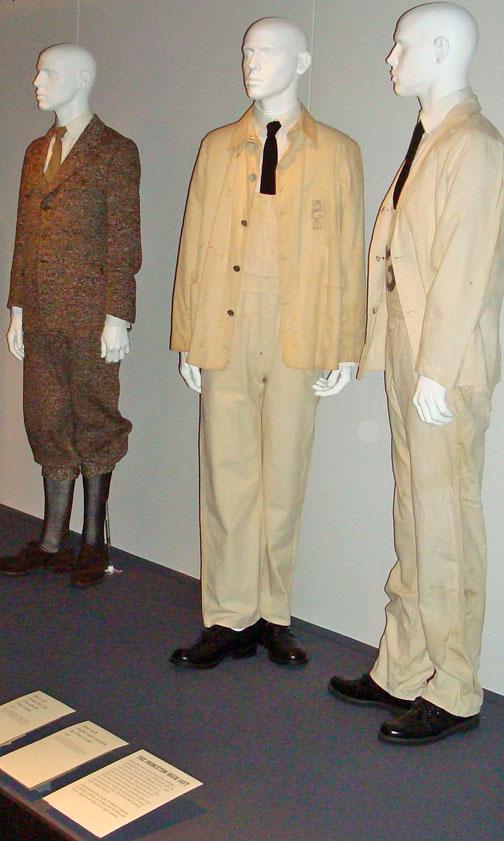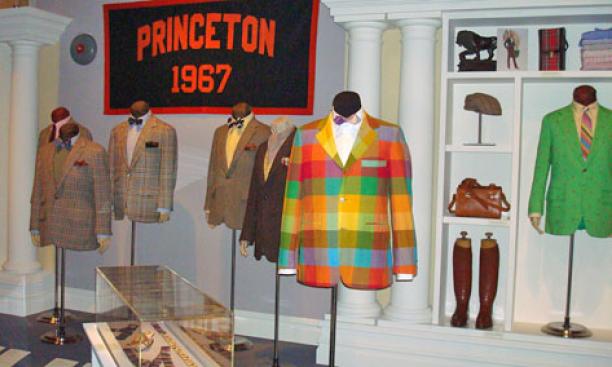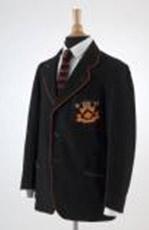
Alexander they say tried to conquer the world
With a helmet and a shield to boot
He should have known he would fail
With all that armor and mail
When all he needed was a Brooks Brothers suit
— Clark Gesner ’60, Ivy League Look

Now and again, we have documented the variety of my academic shortcomings – not a classicist (declension phobic), not a rocket scientist (acrophobic), not a psychologist (phobia phobic), etc. Today, however, we plumb exciting new depths in the talent pool by examining my efforts as a fashionista. Even beyond the pith helmet, believe it or not.
You would bet Aunt Edna’s tweed coat and pearls that anyone glimpsing my visage to the right would avoid my take on haute couture, but over the summer the stylish folks from New York City’s Fashion Institute of Technology (inevitably known as FIT to its familiars) felt my quals in the realm of Princetoniana – presumably including the wonders of the beer suit and the Band blazer – made me the go-to Tiger for their snazzy new exhibit, “Ivy Style,” which runs through Jan. 5.
As it turned out, the beer suit was indeed the key to their level of desperation – uniquely Princetonian, there was no alternative in the madras-skirt universe to the stenciled wonders of our century-old senior-class attire. I was merciful enough to send the FIT Museum folks directly to somebody who actually knew what he was doing – John Wriedt ’85, the keeper of the Princetoniana jacket collection (newly renamed in honor of the late Bob Rodgers ’56) – but not before attempting a guarded glimpse into the somewhat bizarre tale of how Ivydom in the form of This Side of Paradise became a driver of fashion in the Western world. Not to mention a museum exhibit.
Brooks Brothers and J. Press predate the Ivy aesthetic; they were waiting and poised to be aligned toward the image of the new leisure class immediately following World War I, when U.S. culture, suddenly shown the world, decided to become worldly. Ironically, this coincided with Prohibition, a throwback to a 19th-century rural ethos that not only was doomed, but will remain forever a blatant master’s thesis in the Law of Unintended Consequences. And into this whirling mix of social potential stepped Scott Fitzgerald ’17 ( or “F,” as he’s known in some of the funnier Triangle skits).

One of the intriguing facets of the FIT show is that, unlike the politically correct groupthink of anything formally controlled by the Ivies – the league website always has something positive to say about Columbia football, for example – the exhibit’s entry gallery bluntly attributes the creation of Ivy Style to Princeton. Noting our remove from the urban hustle and the homogeneous student body in the ’20s, it presents Tigertown as the perfect incubator for the studied, painstakingly crafted casual look that remains with us in various forms today ( Fashion Week in New York this fall was a fine example, coincidentally). And front and center as you enter are Princetoniana’s beer suits (ironically, from Prohibition) and extensive passages from This Side of Paradise:
“I want to go to Princeton,” said Amory. “I don’t know why, but I think all Harvard men are sissies, like I used to be, all Yale men wear big blue sweaters and smoke pipes. … I think of Princeton as being lazy and good-looking and aristocratic.”
Sure enough, the classic black reunion blazer of the Class of 1923 is one of the core marketing symbols of the exhibit, and peerlessly iconic.
Some of the crucial steps along the Ivy style metamorphosis of the last 90 years are quirky: the raccoon coat (which apparently turned up first at Princeton, of course, in 1921); the monumental introduction of the “odd jacket,” initially half a tweed suit, to become the sports coat, ubiquitous badge of academia; the integration of khakis from returning World War II vets into the look in the ’50s; and The Man in the Gray Flannel Suit, the archetype of establishment conformity. After my generation tried to kill off anything that wasn’t tie-dyed (and of course, failed), the thunderous counterattack of The Preppy Handbook in 1980 – the wannabe bible of Amory’s grandchildren – gave new vigor to Ralph Lauren, Tommy Hilfiger, and the other various acolytes around the high altar of Brooks Brothers. And there the look holds firm today, with a significant number of fashion houses still achieving liquidity through button-down collars, rep ties, and very scary things with little ducks on them. (This is also the perfect spot for a dressage joke, but I’d like it noted that in this instance I’ve left my jodhpurs to others.)
However, speaking of jokes, I have the uncomfortable feeling that some readers might take this seriously, like quantum mechanics or global warming or Kierkegaard. There are many ardent citizens, especially when approaching the museum at FIT from “Fashion Avenue” (7th Avenue in New York), who appear to. Folks, this is humorous. Not only is the Official Preppy empire at least partly satirical (I hope to God), but even in the heart of Princeton the rather outre aspects of the traditional Ivy approach long have been taken with tongue firmly in cheek, certainly including the Princeton University Band’s jarring attack upon the eyeballs with its boater and plaid blazer, as we noted earlier in the fall. And only five years after their debut, one of the great melodic Princetonians, Clark Gesner ’60 , started writing for the Triangle Show and zeroed in on that “Ivy League Look” (see the full lyrics here and see a recent revival performance, accompanied by heartwarming “Harvard Sucks” cries from the audience, here ). “Just dress the discreet way, the smart Rogers Peet way.” Gotta make “F” proud! It doesn’t get more funny than that.

Fifty-five years after that was cuttingly written (with pinking shears?), it’s discomforting to think that a large chunk of America still imagines Princeton in those stylized terms, although listening closely to one band halftime show or one PLOrk concert or one Toni Morrison seminar probably would disabuse them. The Ivy Style has long since diffused itself through the culture, and today the random Princeton sophomore staggering to an 11 a.m. Monday class looks no different than his opposite number at Western Michigan. But of course, that would hardly be a surprise to Fitzgerald, who saw it coming from the outset. Consider the rumination of Amory Blaine:
“I’m not sentimental — I’m as romantic as you are. The idea, you know, is that the sentimental person thinks things will last — the romantic person has a desperate confidence that they won’t.”

